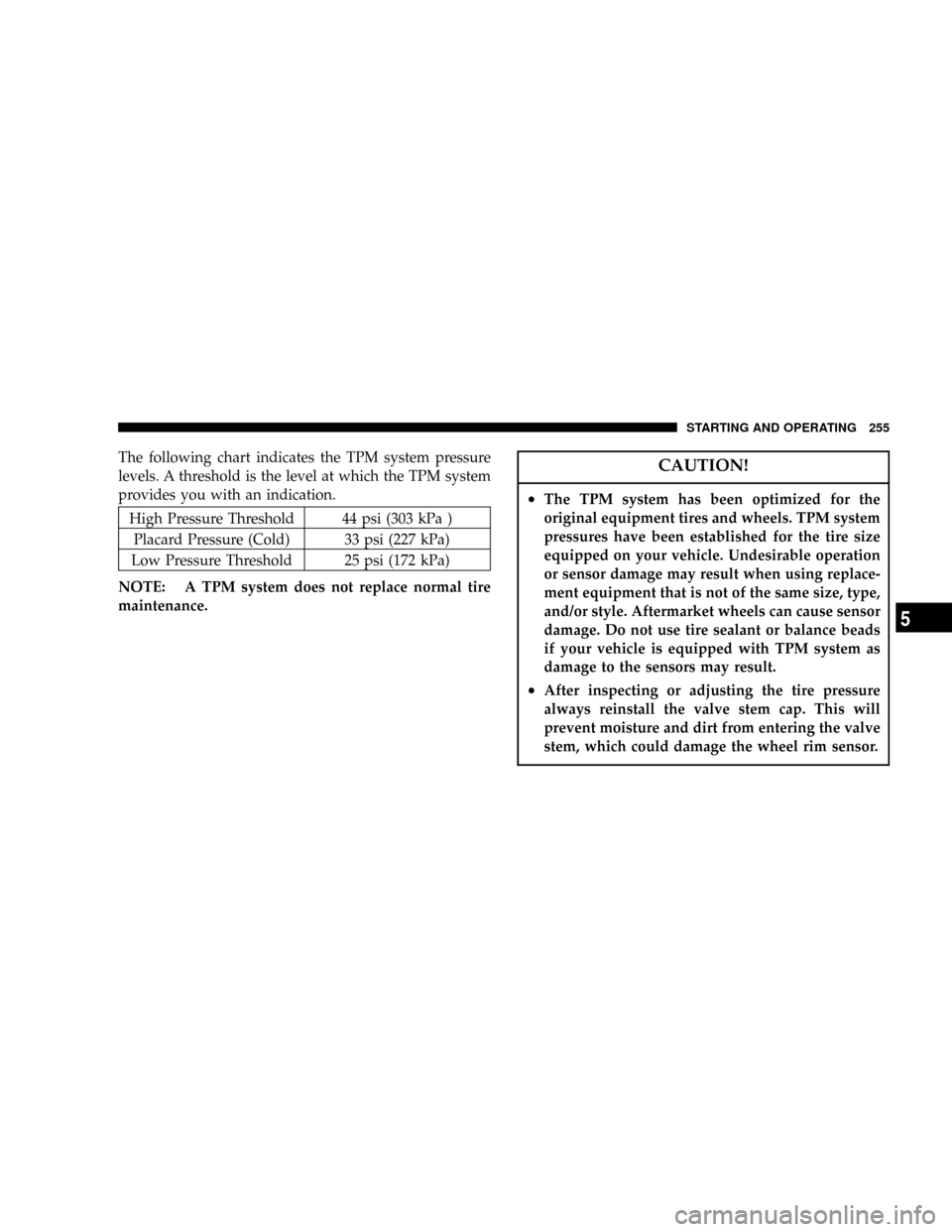Page 119 of 374

NOTE:The tire pressure sensors must be retrained after
rotating the tires or replacing one or more sensors. If a
wheel rotation is not followed by the retrain procedure,
the system will not properly inform you of the correct
vehicle location for a low or high pressure tire.
The following describes how to use this feature:
1. Locate the training magnet in the glove compartment
(shaped like a doughnut).
2. Press the MENU button until RETRAIN TIRE SEN-
SORS is displayed.
3. Press the STEP button to select YES to retrain TPM
sensor.
4. Press the MENU button to enter selection.
5. Display will read TRAIN LEFT FRONT TIRE.NOTE:There is a 60 second timer for training the first
tire and a 30 second timer between training the remain-
ing tires. If either of these timers expire, the EVIC will
abort the training procedure.
6. Starting at the left front tire, place the training magnet
over the valve stem until the horn chirps (This takes
approximately 5 seconds).
UNDERSTANDING THE FEATURES OF YOUR VEHICLE 119
3
Page 120 of 374
7. Repeat step 6 working clockwise around the vehicle
(Left Front, Right Front, Right Rear, Left Rear, Spare) until
all five TPM sensor positions are trained.
8. Return magnet to storage location.If the display reads TRAINING COMPLETE, pressing
either the STEP, C/T, RESET, or MENU buttons will exit
the training mode.
If the display reads TRAINING ABORTED, move the
vehicle ahead at least 1 foot and complete steps 1±8
again.
For further assistance, questions, or comments about the
Tire Pressure Monitor system, please call1±877±774±
8473.
Mini-Trip Computer
This feature, located in the overhead console, displays
information on outside temperature, compass direction,
and trip information.
Reset Button
Use this button to reset the Average Economy, Trip Miles,
and Time Elapsed displays to zero. This will occur only if
120 UNDERSTANDING THE FEATURES OF YOUR VEHICLE
Page 121 of 374

a resettable function is currently being displayed (Aver-
age Economy, Trip Miles, and Time Elapsed). A single
chime will sound to indicate that a reset has occurred.
Global Reset
If the RESET button is pressed twice within 3 seconds
while in any of the three resettable displays, the RESET
button will reset all three displays.
A chime (two beeps) will sound to indicate that a reset
has occurred.
Menu Button
Press the Menu button to scroll through the following
screens: LANGUAGE, DISPLAY U.S. OR METRIC,
AUTO DOOR LOCKS, AUTO UNLOCK ON EXIT, RE-
MOTE UNLOCK DRIV DOOR 1ST, SOUND HORN
WITH LOCK, FLASH LIGHTS WITH LOCKS, HEAD-
LAMP DELAY, SERVICE INTV, LOW FUEL CHIME,
TRAIN REMOTE, and RETRAIN TIRE SENSORS.
C/T Button
Press the C/T button to display the outside temperature
and one of eight compass readings to indicate the direc-
tion the vehicle is facing.
WARNING!
Even if the display still reads a few degrees above
32ÉF (0ÉC), the road surface may be icy, particularly
in woods or on bridges. Drive carefully under such
conditions to prevent an accident and possible per-
sonal injury or property damage.
Step Button
Press the STEP button to cycle through all of the displays.
The displays are: Average Miles/GAL, Miles To Empty,
Trip Miles, Time Elapsed, Miles To Service, Tire PSI, and
Blank Screen.
UNDERSTANDING THE FEATURES OF YOUR VEHICLE 121
3
Page 151 of 374

INSTRUMENT CLUSTER DESCRIPTION
1. Tachometer
Indicates the permissible engine revolutions-per-minute
for each gear range. Before reaching the red area, ease up
on the accelerator to prevent engine damage.
2. Turn Signal Indicator Light
The arrows will flash in unison with the exterior
turn signals, when using the multi-function control
lever. A chime will sound if the turn signals are left on
continuously for 2 miles (3 km) until they are deacti-
vated.
3. High Beam Indicator Light
This light shows that the headlights are on high
beam. Pull the multi-function control lever to-
wards the steering wheel to switch the headlights from
high to low beam.4. Speedometer
Indicates vehicle speed.
5. Tire Pressure Monitor Warning Light Ð If Equipped
This light will turn on when there is a low tire
pressure condition. The light will also turn on
if a problem exist with any tire sensor. The light
will remain on until the tire pressure is prop-
erly set or the problem with the sensor is corrected.
This light will turn on momentarily as a bulb check when
the engine is started.
When the ªTire Pressure Monitor Warning Lightº is lit,
one or more of your tires is significantly under-inflated.
You should stop and check your tires as soon as possible,
and inflate them to the proper pressure as indicated on
the vehicle's tire information placard. Driving on a
significantly under-inflated tire causes the tire to over-
heat and can lead to tire failure. Under-inflation also
reduces fuel efficiency and tire tread life, and may affect
UNDERSTANDING YOUR INSTRUMENT PANEL 151
4
Page 208 of 374

NShifting Procedure....................230
mTrac-LokŸ Rear Axle Ð If Equipped.........231
mParking Brake.........................232
mAnti-Lock Brake System Ð If Equipped.......234
mOn-Road Driving Tips...................236
mOff-Road Driving Tips...................236
NWhen To Use 4L Or 4 Lo (Low) Range......236
NIn Snow, Mud And Sand................237
NHill Climbing........................237
NTraction Downhill.....................238
NAfter Driving Off-Road.................238
mTire Safety Information...................239
NTire Markings........................239NTire Identification Number (TIN)..........243
NTire Loading And Tire Pressure...........244
mTires Ð General Information...............248
NTire Inflation Pressures.................249
NHigh Speed Operation.................250
NRadial-Ply Tires......................251
NTire Spinning........................251
NTread Wear Indicators..................252
NReplacement Tires.....................252
NAlignment And Balance.................253
mTire Pressure Monitor System Ð If Equipped . . . 254
NTire Pressure Monitor System Tire/Wheel
Rotation And Sensor Replacement
Ð If Equipped.......................256
208 STARTING AND OPERATING
Page 254 of 374

Tires may also cause the vehicle to pull left or right.
Alignment will not correct this problem. See your dealer
for proper diagnosis of the problem.
Improper alignment will not normally cause vehicle
vibration, which may be a result of tire and wheel
out-of-balance. Proper balancing will reduce vibration
and avoid tire cupping and spotty wear.
TIRE PRESSURE MONITOR SYSTEM Ð IF
EQUIPPED
The Tire Pressure Monitor System (TPM) monitors the
pressure in all 4 road tires and the full size spare. The
TPM system uses wireless technology to monitor tire
pressure levels. Sensors, mounted to each wheel as part
of the valve stem, transmit tire pressure readings to a
receiver located in the overhead console. The tire pres-
sure status is shown in the Electronic Vehicle Information
Center (EVIC) display. Refer to ªOverhead Consoleº inSection 3 for more information. The TPM system func-
tions even when the EVIC is not set on the tire pressure
display screen.
The TPM system informs you of a low or high tire
pressure condition. If this occurs, correct your tire infla-
tion pressure as soon as possible, and inspect all of your
tires. Be sure to use a high quality gauge when adjusting
pressure. The TPM system is designed to monitor your
tire pressure but will not function as a tire pressure
gauge. There will be a delay between the instant you
adjust the air pressure in a tire and when the system
updates the display. The TPM system is not intended to
provide you with notification of rapid air loss.
254 STARTING AND OPERATING
Page 255 of 374

The following chart indicates the TPM system pressure
levels. A threshold is the level at which the TPM system
provides you with an indication.
High Pressure Threshold 44 psi (303 kPa )
Placard Pressure (Cold) 33 psi (227 kPa)
Low Pressure Threshold 25 psi (172 kPa)
NOTE: A TPM system does not replace normal tire
maintenance.
CAUTION!
²The TPM system has been optimized for the
original equipment tires and wheels. TPM system
pressures have been established for the tire size
equipped on your vehicle. Undesirable operation
or sensor damage may result when using replace-
ment equipment that is not of the same size, type,
and/or style. Aftermarket wheels can cause sensor
damage. Do not use tire sealant or balance beads
if your vehicle is equipped with TPM system as
damage to the sensors may result.
²After inspecting or adjusting the tire pressure
always reinstall the valve stem cap. This will
prevent moisture and dirt from entering the valve
stem, which could damage the wheel rim sensor.
STARTING AND OPERATING 255
5
Page 256 of 374

Tire Pressure Monitor System Tire/Wheel
Rotation and Sensor Replacement Ð If Equipped
With the TPM System, if a road tire and wheel is replaced
by the spare, the TPM system will detect the swap
automatically (after the ignition has been cycled) and
display SPARE SWAP DETECTED along with a chime.
This could take up to 10 minutes with vehicle speed
above 25 mph (40 km/h).
The tire pressure sensorsmustbe retrained following a
wheel rotation or sensor replacement. Refer to ªEVIC Ð
Retrain Tire Sensorsº in Section 3 for more information. It
is necessary to program the EVIC with the new sensor(s)
or the new position of each sensor as it is rotated to a
different corner of the vehicle.
If a wheel rotation is not followed by the retrain proce-
dure, the system will not properly inform you of the
correct vehicle location of a low or high tire pressure.
Tire Pressure Monitor System/4±LO Mode Ð If
Equipped
When the 4±LO mode is selected, the chime will not
sound until either: the vehicle speed is greater or equal to
25 mph (40 km/h) or the vehicle is taken out of the 4±LO
mode.
The low tire pressure warning messages (on the EVIC)
and the ªTire Pressure Monitor Warning Lightº will
continue to be displayed until the tire pressure has been
increased to the proper operating pressure.
General Information
This device complies with part 15 of the FCC rules and
RSS 210 of Industry Canada. Operation is subject to the
following conditions:
²This device may not cause harmful interference.
256 STARTING AND OPERATING